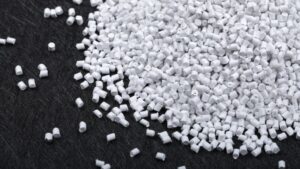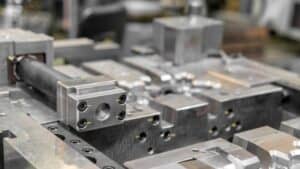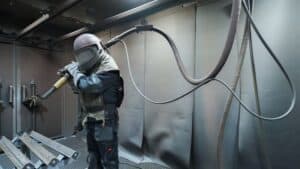
Injection molding is a popular method used to create plastic parts by injecting molten plastic into a mold. Key components, along with the types of plastic materials used, play crucial roles in shaping the final product.
Injection molding involves the creation of parts by injecting molten plastic into a mold. The process starts with heating plastic granules until they melt. This molten plastic is then injected into a mold under high pressure. The mold, which dictates the shape and features of the final part, cools the plastic, allowing it to solidify and form the desired shape.
Key Components of Injection Molding Machines
An injection molding machine consists of three main sections: the injection unit, the mold, and the clamping unit.
- Injection Unit: This part melts and injects the plastic. It includes a hopper, heater, and a screw/plunger that pushes the molten plastic into the mold.
- Mold: Made up of two halves, it shapes the plastic. The core and cavity form the interior and exterior surfaces of the part.
- Clamping Unit: It holds the mold halves together during the injection and cooling stages, ensuring the part is accurately shaped and formed.
How to Design Mold Cavities?
When designing mold cavities, you need to consider several aspects that influence the final product’s quality and efficiency. Understanding the role of the core and cavity, choosing appropriate design factors, and deciding on the type of mold are vital steps in the process.
What is Mold Cavity in Injection Molding?
A mold cavity is a crucial element in the injection molding process. It refers to the hollow space within a mold that defines the shape and dimensions of the plastic part being produced. Key points about mold cavities include:
The mold cavity is a hole or negative space shaped like the desired final part. It’s typically made from stainless steel.
When molten plastic is injected into the mold, it fills the cavity, taking on its shape. Once cooled and solidified, this forms the finished plastic part.
Normally, there are three types of mold cavities:
- Single cavity molds: Produce one part per cycle
- Multi-cavity molds: Have multiple identical cavities, producing several identical parts per cycle
- Family molds: Have multiple different cavities, producing different parts in one cycle
Factors Affecting Cavity Design

Several key factors influence the design of the cavity within a mold, starting with part geometry; intricate shapes may require advanced configurations to form all features while maintaining mold functionality accurately, and appropriate draft angles are essential for easy ejection.
Material selection also plays a vital role, as different materials exhibit varying flow characteristics, shrinkage rates, and thermal properties, necessitating tailored designs to ensure proper filling and cooling.
Additionally, the integration of efficient cooling channels is crucial for controlling temperature and reducing cycle times while preventing warping or defects. Flow dynamics must be considered to ensure that molten material fills the cavity uniformly without voids, and the design of gates and runners is essential for optimizing material flow.
Lastly, consideration of secondary operations, such as machining or painting, is important to ensure that the cavity design accommodates any additional processing needs. By carefully addressing these factors, manufacturers can create effective molds that yield high-quality parts efficiently and economically.
Core vs. Cavity: What are the Differences?
The cavity shapes the outside of the part, while the core defines the inside. Together, they create the complete shape of the product. When the two halves of the mold close, the core and cavity fit together to create the final design.
In a typical two-part mold, the cavity is often housed in the stationary half, while the core is located in the moving half of the mold.
The method of ejection also differs; after cooling, the part is typically removed by separating the mold halves, allowing the cavity and core to disengage from the formed product.
Single-Cavity vs. Multi-Cavity Injection Molds: What are the Differences?
In plastic injection molding, choosing between single-cavity and multi-cavity molds is crucial for determining production efficiency, mold cost, and part quality.
A single cavity mold contains one cavity, producing one part per cycle. This design is particularly advantageous for low to moderate production volumes, allowing for lower initial tooling costs, easier mold maintenance, and the flexibility to modify designs as needed.
Single cavity molds excel in prototyping and creating custom parts, where precision is more critical than volume.
On the other hand, a multi cavity mold incorporates several cavities within a single mold, enabling the simultaneous production of multiple identical parts with each injection cycle. This method not only increases production speed but also lowers the cost per unit, making it ideal for mass production. Multi cavity molds are essential in industries requiring large quantities of identical parts, as they ensure consistency and minimize the risk of defects across products.
However, they come with higher initial tooling costs and require more sophisticated engineering. Furthermore, there are considerations regarding cycle time. Multi cavity molds can significantly reduce cycle time since they produce multiple parts simultaneously. However, the complexity of these molds can result in longer setup times and necessitate advanced maintenance protocols to address issues like cavity imbalance and wear over time. Conversely, single cavity molds allow for quicker adjustments and troubleshooting, making them more manageable when dealing with unique or one-off parts.
Another important aspect is the scalability of production. While single cavity molds can be ideal for smaller batches or custom products, multi cavity molds allow companies to scale up production rapidly to meet market demands without compromising on quality.
Why Choose Molide?
Founded in 2008, Moldie has established itself as a leader in crafting superior-quality plastic injection molds, die casting dies, and precision mechanical parts. We offer a complete OEM/ODM solution, covering everything from part design and prototyping to mold design, production, and large-scale manufacturing.
Our expertise is trusted by international industry leaders. We serve prestigious automotive brands like Mercedes-Benz, Volkswagen, Audi, BMW, and Ferrari, as well as major players in other sectors such as Schneider and Phillip.
Whether you need plastic injection molds, die casting dies for Aluminum, Zamak, and Magnesium, or precision mechanical parts, Moldie has the capabilities to meet your diverse manufacturing needs! Contact us today!
Frequently Asked Questions
How can you understand an injection mold cavity diagram?
To read a mold cavity diagram, look for labels indicating the cavity and core sides. Pay attention to the design elements such as the mold base, sprue, and runner system. These diagrams help visualize how melted plastic flows and fills the cavities to form parts.
Could you explain the cavity molding process?
The cavity molding process begins when molten plastic is injected into the mold cavity. The mold is then cooled to solidify the part. It’s crucial that the mold is designed precisely, as any errors can affect the quality and accuracy of the produced parts.
What factors into the cost of a single cavity injection mold?
Several factors influence the cost of a single cavity mold. These include the complexity of the part, the material used in the mold itself, and production volume. Tooling precision and additional functionalities, such as automated features, also play a role in determining cost.






